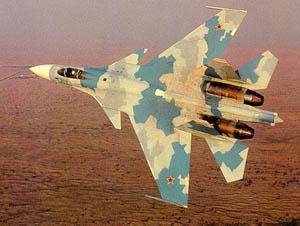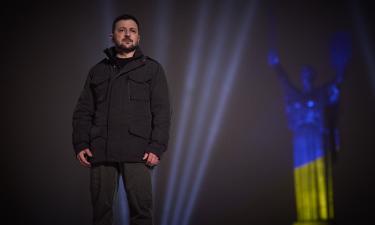Russian Air Forces use "intelligent" airplanes
In the end of the last year, Russia's Air Forces received 5 new fighter planes Su-27 SKM (modernised). This year there will be at least 20 of them. As the engineers and military officials comment, these fighter jets would become the first step towards switching the Russian Army to the fifth generation jetfighter ("Izvestia" information)
 The main thing that makes Su-27 SKM stand out from the rest of the Army's Su's is that this new machine can work on both air and ground targets with the same ease. The entire specter of both non-controlled and controlled type of bombs is used for this, plus various aviation missiles. The jetfighter can use all this arsenal with no regard to neither time of the day nor to the weather conditions: pilot can drive his machine and also do bombing with the help of special equipment, explained Igor Demin, the chief constructor of "OKB Sukhoi".
The main thing that makes Su-27 SKM stand out from the rest of the Army's Su's is that this new machine can work on both air and ground targets with the same ease. The entire specter of both non-controlled and controlled type of bombs is used for this, plus various aviation missiles. The jetfighter can use all this arsenal with no regard to neither time of the day nor to the weather conditions: pilot can drive his machine and also do bombing with the help of special equipment, explained Igor Demin, the chief constructor of "OKB Sukhoi".
"Human just needs to press "Fire" button in the right time. Yet another know-how is the radio location station of the jetfighter, which can track not only the air targets, but also the moving ground ones", he added.
Su-27 SKM is not very different from the normal Su jetfighters by appearance, however its cabin was seriously modernised. Near its usual analogue arrow meters three LCD monitors were placed, they display all flight and combat information.
The constructors comment this was made to gradually teach pilots they can observe the situation not only by arrows' movement, but by display's data too. Their greatest convenience is that all information can be found in one place.
The first Su-27 SKM will receive Lipetsk aviation center pilots, Russia's military aviation elite. Now they are on duty in Russian base Kant, Kyrgyzstan.
They have to fulfill the last condition to allow wide switch from old Su's to the new ones: prepare documentation and final report on usage of this new machine in various climate and weather conditions. This has to be done in short time: Su-27 SKM is planned to be supplied to the forces massively in the second half of 2004.
This year, "Sukhoi" is to start work on creation of a new, revolutionary machine, Su-35.
In 2004 "OKB Sukhoi" is starting experimental and construction works on new revolutionary jetfighter, Su-35. This machine is to become a bridge to the fifth generation jetfighters.
Su-35 will not have any analogue, arrow controls and monitors. Instead of the three LCDs there will be 2 big ones. To maximise the area of information displayed, their screens would have windows, similar to Picture-in-Picture technology in modern TVs.
Additionally, the most important of flight and combat information will be displayed in the pilot's helmet. This will free the pilot from constant need to look at the cabin's monitors before him, so that he is able to move his head around, visually evaluating the situation.
Moreover, Su-35 will be also harder to see for radiolocation stations. This can be done by using special radio waves-swallowing finish, a new paint of the jetfighter in fact. And certainly, the most serious developments to happen with engines and the main computer. They would finally become one whole.
Su-35 engines will have greater power and elasticity, which would give the machine more speed and maneuverability. Hydrodynamic controls of the power engines are to be changed to electrical. Constructors claim this would not only save space and weight, but also would allow a "parallel" control of the machine.
What it means in practice, is that the pilot's role will be less notable. The computer will be deciding what speeds and which regimes the machine is to approach targets, at which moment the pilot can be allowed to use weapons. Human will not be able to make any wrong decisions: the computer would simply switch off his controls and advice him what is the fault.
Demin believes that if the fifth generation jetfighters would still have pilots, the next generation planes will do without them. Yet some can not agree with him, including Givi Dzandzagava, President of "Technocomplex" scientific & producing center uniting 16 companies working on various equipment of Su-27 SKM.
"While the intellect level of the jetfighters' on-board equipment will be very high, we still have to leave for human an opportunity to make combat decisions at the top of the technical abilities of machines and weapons. A task given can be completed even at the cost of one's own life. Decisions on weapons use and responsibility following lies on human and no one else"
The fifth generation jetfighter is machine with brains and eyes
Dzandzagava goes on: "Today we can only generally visualise the cabin of the fifth level fighter planes, and it would resemble Su-35's cabin very much"
What is known for certain: displays of the cabin and of the pilot's helmet will feature much more information. Analogue scales with arrows and numbers will disappear for good, all the information will be in visual form. Like in prestige cars: symbols and icons.
Su-35 on-board computer processors receive information from 150 various antennas and devices, placed all over the jetfighter's body.
The fifth level airplane will have many times more such "feelings". It will be legible to say that new jetfighter feels the situation with its skin. Today there is already a task set to raise intellectual potential of the on-board computer.
Su-27 SKM tactical and technical characteristics:
Year official approval as an army machine: 1998. Maximal speed, km/h: at low heights: 1400, at the height: 2430. Practical height ceiling, meters: 18,000. Maximum flight distance, km: 3680. Maximum exploitation overload: 9. Crew: 1. Weapons: automatic one-barrel 30mm gun GS-301 (1,500 shots/min, 150 bullets). Maximum combat load: 8000 kg. The chassis' 10 bases can be equipped with "air-air" and "air-ground" rockets, and various non-controlled and correctable bombs.
"Izvestia"
Subscribe to Pravda.Ru Telegram channel, Facebook, RSS!




